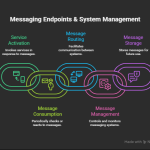Hosts: Sagar Sharma & Jochen Toelen
Guest: Kent Weare – Principal PM Manager (Azure Logic Apps, Microsoft)
If you think integration is just about connecting APIs and dropping messages on a queue, think again. It’s evolving—fast. And if you’re still treating hybrid integration like a temporary phase, you’re in for a surprise.
That’s exactly why Jochen Toelen and I sat down with none other than Kent Weare from Microsoft—Principal PM for Azure Logic Apps—to talk about where integration is headed and what it means for architects, developers, and IT leaders. This two-part podcast wasn’t just a conversation—it was a masterclass on modern integration strategy straight from the heart of Microsoft.
Whether you’re knee-deep in a BizTalk-to-Azure migration, exploring Azure Arc, or trying to understand how AI will shape orchestration, this one’s for you.
Part 1: Cloud-First Integration – Rethinking the Strategy
In the first episode, we unpack the strategic drivers behind the shift from traditional integration platforms like BizTalk Server to Azure-native and hybrid architectures.
From my own work with enterprise clients, I’ve seen the pressure to modernize grow dramatically—compliance, global scalability, and rapid innovation just don’t sit well with legacy stacks anymore.
What you’ll hear in Part 1:
- Why enterprises are re-evaluating BizTalk and moving toward Azure Integration Services (AIS).
- What’s new with Azure Arc and how it extends Logic Apps into hybrid environments.
- Microsoft’s commitment to governance, security, and regional compliance—especially critical for customers in the EU.
- The rise of agentic workflows, AI-infused automation, and how Microsoft is enabling that shift.
- My take on migration: it’s not just a lift-and-shift—it’s an opportunity to redesign with agility and scale in mind.
Part 2: Architecting the Future – Resilience, AI & Unified Observability
This is where things got deep and exciting.
In Part 2, Kent breaks down how Azure Integration Services is becoming more intelligent, resilient, and connected—and why that matters for building long-term digital ecosystems.
I especially appreciated the focus on observability and unified process tracking, something that every integration architect (including myself!) dreams of having in a multi-tenant, globally-distributed environment.
Key topics we explored:
- Hybrid vs. Cloud-Native: It’s no longer a binary decision. We discussed how Azure Arc lets you operate in both worlds.
- Operational clarity: New capabilities in Integration Environment bring much-needed visibility across distributed workloads.
- BizTalk Migration: Realistic timelines, lessons learned, and where Microsoft is investing to make this journey smoother.
- AI and the Integration Fabric: Think AI agents automating flows, interpreting data, and enhancing decision logic.
- Governance at scale: How to build trust with auditability, compliance, and role-based control across regions.
Kent also dropped hints about what’s next for Logic Apps, and let’s just say—if you’ve ever struggled with large-scale orchestration or business process visibility, the future looks promising.
🎯 My Key Takeaways
Here’s what stood out to me as an architect deeply involved in modernizing integration platforms for global clients:
| Theme | What We Learned |
|---|---|
| Cloud & Hybrid | Hybrid is here to stay—but it’s getting way more powerful and manageable. |
| Migration Strategy | Moving off BizTalk isn’t just a technical project—it’s a transformation opportunity. |
| Compliance First | Microsoft is building integration that understands regional regulations, not just APIs. |
| AI Enablement | Integration is becoming smarter—this isn’t just “if-then-else” logic anymore. |
| Unified Monitoring | No more stitching together logs. Microsoft’s unified observability is a game-changer. |
📢 Final Thoughts
This podcast was packed with insight, strategy, and the kind of practical wisdom that only someone like Kent Weare could deliver. As someone who’s been part of complex integration projects across cloud and hybrid ecosystems, this conversation gave me even more confidence in where Azure Integration Services is headed—and why now is the time to rethink your integration strategy.
If you’re an architect, developer, or business decision-maker—don’t miss this two-part series. Your future self will thank you.


